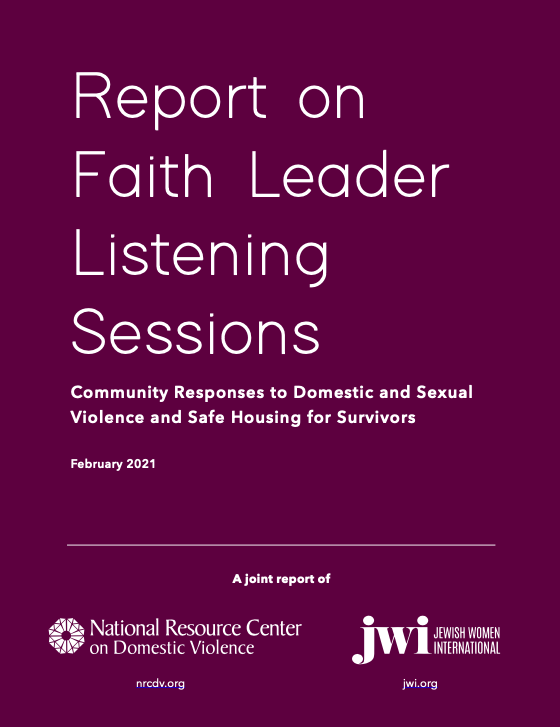By NRCDV’s Policy and Research Team
Domestic violence is a leading cause of both survivor homelessness and housing instability. Those experiencing homelessness or housing insecurity are more vulnerable to violence. Survivors need flexible, affordable, and safe housing options to achieve safety and lasting stability. Many survivors turn to their friends, family, and faith leaders for housing support.
For survivors of violence, safety is a broad concept. It’s not limited to reducing physical violence or a partner’s controlling behavior. Safety includes access to essential human needs, like food and shelter. It's also about attending to the social and emotional wellbeing of survivors.
What are faith leaders doing to address domestic violence in their communities?
 In collaboration with Jewish Women International, the National Resource Center on Domestic Violence (NRCDV) spoke with faith leaders of different identities and backgrounds. They identified barriers faith communities face in confronting domestic violence. They also reflected on their creative responses. In these conversations, it became clear that these faith leaders refused to simplify the complicated issue of domestic and sexual violence. Instead, they confronted its complexity and honored its nuance.
In collaboration with Jewish Women International, the National Resource Center on Domestic Violence (NRCDV) spoke with faith leaders of different identities and backgrounds. They identified barriers faith communities face in confronting domestic violence. They also reflected on their creative responses. In these conversations, it became clear that these faith leaders refused to simplify the complicated issue of domestic and sexual violence. Instead, they confronted its complexity and honored its nuance.
These practices could serve as models for other faith communities to follow. While each community held specific strengths and challenges, four themes emerged:
Actions Taken by Religious Institutions & Religious Leaders:
The faith leaders recognized that people have used religion to control survivors. So, they promoted theologies of love and condemned domestic violence. Many faith leaders gave sermons on domestic violence. One reverend uplifted his community’s Domestic Violence Contextual Bible Study. One nonprofit encourages imams to hang declarations against domestic violence in their mosques. To do this work responsibly, faith leaders noted the need for training and protocols. Leaders must complete training that prepares them to respond to disclosures of harm. They also need to take steps toward prevention and cultural shifts.
One pastor shared an innovative model within her own denomination. Using a “train the trainer” model, AVA (Advocacy for Victims of Abuse) advocates are trained together. Then, they return to their own communities and local congregations to find community partners, work with their local religious and lay leaders, and educate the community.
Actions Taken by the Faith Community:
Faith leaders lifted up the power of close communities to respond to survivors’ needs. Many times, congregants opened their homes to survivors and their families or offered a place to live at a reduced rate. One leader explained,
“The housing solutions were often internal, informal and again, part of what I experienced as a very positive community network of being present for one another and making these really very generous offerings of resources, of their homes.”
But faith communities did not always offer support. Leaders spoke of stigma and shame. This was especially true when the survivor and person causing harm were part of the same community. An imam explained that a survivor may leave their community if they were not believed.
“They feel shame that everyone believes they have lied about this and the guy is like a hero, a victim.”
Actions Taken in Partnership with External Organizations:
Participants spoke of referring survivors to local domestic violence organizations. A former pastor of Metropolitan Community Church (MCC) congregations spoke to the importance of “warm introductions.” He connected survivors not to the general organization but with advocates he knew there. These were organizations he and his congregations had strong relationships with:
“We weren’t just handing folks off for resources… we were engaged with each other’s work around common goals related to spiritual justice, gender-queer social justice, immigrant justice.”
Barriers to all:
Faith leaders struggled with funding. They relied on grants and donations to support their efforts. Participants also discussed bias, discrimination, and limited access to traditional systems. Interactions with the traditional systems sometimes left survivors re-traumatized or re-victimized. Gender-based assumptions could also be significant barriers to LGBTQ-identified survivors seeking support. Sometimes support from a faith community allowed survivors to avoid systems.
How are faith leaders supporting the housing needs of survivors?
Faith communities generated creative responses to address the housing needs of survivors.
These were their primary forms of housing support:
- Using community members’ personal housing
- Using a parsonage for immediate housing
- Offering reduced rate housing through community members and partnerships (apartments, homes, hotels, motels)
- Relying on angel investors to buy affordable housing units
- Offering other forms of support to help survivors maintain existing housing:
- Financial and/or employment help
- Counseling and/or treatment
- Childcare
- Transportation
- Advocacy support, etc.
Faith leaders also advocated alongside survivors seeking safe and affordable housing. One minister listed three forms of housing advocacy his denomination pursues:
- Assisting undocumented immigrants and asylum seekers leaving abusive situations in finding housing
- Helping formerly incarcerated survivors of gender-based violence transition into affordable housing
- Investing in affordable housing for women and children leaving abusive situations
Summary
Faith leaders are uniquely positioned to co-create safe communities and provide support. Listening session participants shared promising practices for this work.
For more information:
Resources:
- Sojourners’ 100 Sermons
- Domestic Violence Awareness Month “Universal Prayer” Video & Text
- TA Bundle: Religion and Domestic Violence: Addressing the Connections
- Transforming Our Coordinated Entry Systems to Increase Survivors’ Access to Housing Options
Organizations Referenced:














